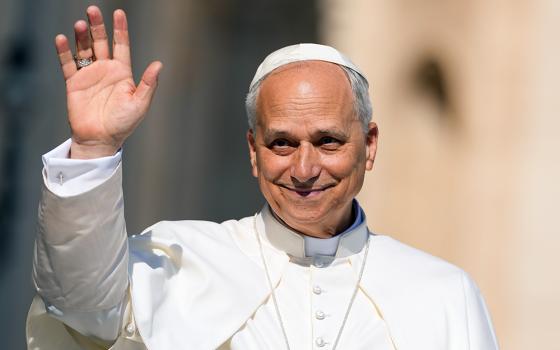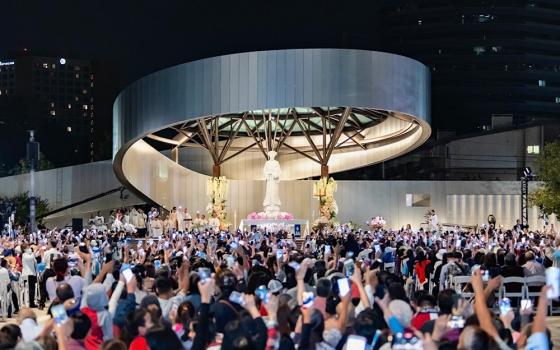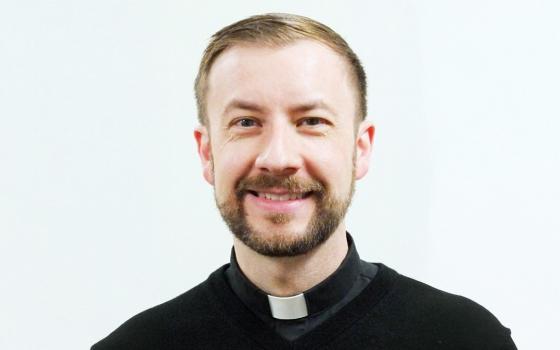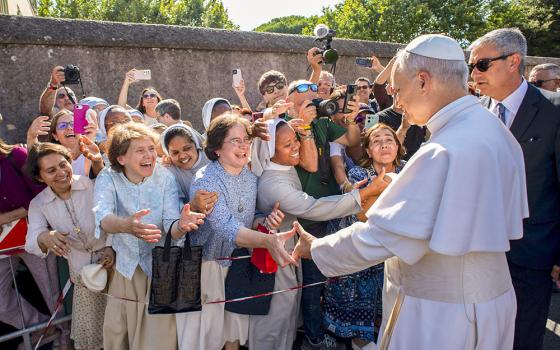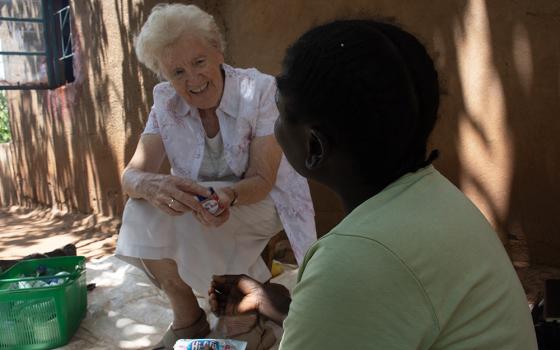Pope Francis speaks with young people in Rome in this undated photo for a documentary, "The Pope: Answers," released by Disney+ April 5, 2023. (CNS/Courtesy Disney+ España)
Pope Francis was, in some ways, the antidote to an image-obsessed media scene. He lived and dressed simply, refusing to judge others according to their appearance and denounced our capitalistic "throwaway culture" that sends mountains of fast fashion to landfills. Yet Francis’ papacy unfolded in an era of extreme visibility, so simple actions like taking the bus instead of a limousine or embracing a disfigured man became viral clickbait. The culture’s fascination with Francis’ papacy indicated a hunger for the simplicity and humility he projected. It was an antidote we craved.
The pageantry of Catholicism had intrigued the modern general public long before Francis came to the scene. However one might personally feel about the church, it’s an imagistic goldmine; and various arts, from opera to cinema to fashion, have capitalized on this. But artistically sophisticated representations of Catholicism rarely coincide with efforts to proselytize, to the frequent dismay of the pious. Paradoxically, Pope Francis’ rejection of proselytizing, his down-to-earth communication style and his pastoral approach made the church look interesting and relevant in a way that propaganda-driven Catholic art could never achieve.
The accessibility of the church under Francis may have had something to do with the Vatican’s involvement in the 2018 Met Gala, the theme of which was "Heavenly Bodies: Fashion and the Catholic Imagination." Some vocal Catholics criticized what they perceived as "blasphemy" in outfits like Rihanna’s pope-inspired costume, but a critique in line with Francis’ theology would have included less stricture of creative interpretations and more severity toward the spectacle of wealth in an era of rampant income inequality. Francis’ pared-down style became a statement in itself, one of anti-fashion.
Francis’ visibility and the age of digital media inevitably meant memes – and lots of them. Some were merely funny, like when the oft-photoshopped picture of the pope celebrating Mass to make it look like he was holding up various random items. A favorite of mine was the viral image of Francis surrounded by African clergy, looking like he was rapping the gospel to the streets. But sometimes the memes were political commentary, like the photo of Pope Francis looking visibly miserable while standing next to President Donald Trump.
Under Francis’ leadership, a more transparent Vatican meant a different kind of storytelling.
So maybe it’s fitting that the lush aesthetics of traditionalist Catholicism, in contrast with the Francis variety, remain a fascinating semiotic zone of moral ambiguity. One of the most memorable cinematic representations of Catholicism is the baptism montage in the first "Godfather" movie, in which scenes depicting Michael Corleone's renunciation of sin at the baptism of his godchild are interspersed with scenes of the brutal assassinations he ordered. The Catholic pageantry invites a contrast between what he professes and what he does; it also highlights the hypocrisy of powerful Catholics. Likewise, in the horror genre, ornate Catholic aesthetics can signify the powers of good ("The Exorcist") or represent a playground for depravity ("The Devils").
Thanks to Pope Francis, the world became aware that a different kind of church was possible: a Vatican II church, less about esoteric practices and more about engagement with real societal challenges. Under Francis’ leadership, a more transparent Vatican meant a different kind of storytelling, evidenced by nuanced film depictions of the papacy, including "The Young Pope," "The Two Popes" and "Conclave." In the latter, released just months before Francis’ death, viewers got a close-up of the inner workings of the Vatican and the struggle to interpret the meaning of church. The story’s sensational elements relate, not to occult struggles, but to deeply human impulses and experiences. It’s not that we don’t still find assassin monks or possessed nuns intriguing. But thanks to the Francis effect, we’ve rediscovered the vitality of a church in the modern world.
One amusing instance of Francis’ influence on popular culture was when "Game of Thrones" cast Pope Francis lookalike Jonathan Pryce (who starred as the pontiff in "The Two Popes") in the role of the High Sparrow, a religious leader who takes a fierce stand on behalf of the people. Many viewers found the casting choice ironic, interpreting the High Sparrow character as religiously intolerant because he cracks down on certain popular characters. But those popular characters are, for the most part, oppressors. This failure to read a character accurately connects with another interplay between Pope Francis and the culture: He was often misunderstood.
The mitre of Pope Pius XI is displayed during a press presentation for the exhibit, "Heavenly Bodies: Fashion and the Catholic Imagination," at Galleria Colonna in Rome Feb. 26. (CNS/Paul Haring)
In his treatise Simulacra and Simulacrum, philosopher Jean Baudrillard wrote about how society has become so dominated by media and representation as to create a level of "hyperreality." Instead of engaging with things themselves, we engage with images of things. That was back in the 1980s. Baudrillard hadn’t seen anything yet.
Much of the discourse around Francis’ legacy had more to do with images of him; literal images, some positive, some negative, some funny, some fueled by hate. Traditionalists wanted to see him as a radical and a villain. Progressives hoped he would be as radical as the traditionalists feared. The ubiquitous impact of the digital age was likely underrated. How much of my sense of Pope Francis' persona is because I retain a vague conviction that he was a rapper?
I expect Francis would have enjoyed many of the memes, but he warned us not to be seduced by the glamor of images, away from our moral obligation to the world. In a church that has frequently protected its privacy while projecting a highly theatrical representation of itself, this remains a challenge for us all — and Francis’ example remains a guide.
Advertisement

